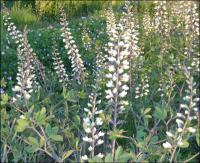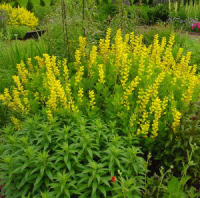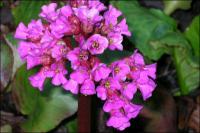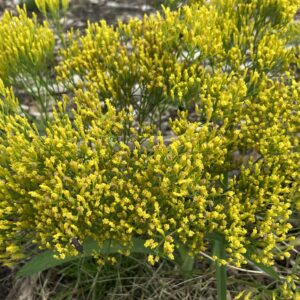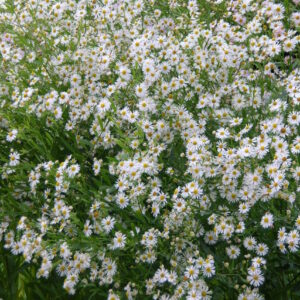Shop
Showing 113–120 of 778 results
-
Baptisia australis syn. Saphora australis False Indigo Z 3-9
Indigo blue racemes in June followed by ornamental black seed pods on this perennial that looks like a shrub. This is a legume that improves soil fertility by making nitrogen available to the Baptisa and surrounding plants. Internationally known garden designer Piet Oudolf’s 100 “MUST HAVE” plants, Gardens Illustrated 94 (2013).
Indigo blue racemes in June followed by ornamental black seed pods on this perennial that looks like a shrub. This is a legume that improves soil fertility by making nitrogen available to the Baptisa and surrounding plants. Internationally known garden designer Piet Oudolf’s 100 “MUST HAVE” plants, Gardens Illustrated 94 (2013).
Size: 3' x 3'
Care: Full sun sandy soil. Heat and drought tolerant, with no staking needed.
Native: Eastern United States, Wisconsin native.
Wildlife Value: Food source for several caterpillars and nectar for a number of butterflies.
Awards: Received England’s Royal Horticultural Society Award of Merit. Perennial Plant Association Plant of the Year Award, 2010. Missouri Botanic Garden Plant of MeritBaptisia is Greek meaning to dye referring to use of the plant as a substitute for indigo dye. Cherokee used Baptisia australis for a number of illnesses: cease mortification, cure toothaches and induce vomiting. Collected by John Bartram (1699-1777) plant explorer and colonial nurseryman by 1748.
-
Baptisia leucantha syn. Baptisia lacteata, Baptisia alba White Wild Indigo, Prairie wild indigo Z 3-9
Gorgeous, tall creamy white flower spikes in May & June followed by black seed pods. This is a legume that improves soil fertility by making nitrogen available to the Baptisia and surrounding plants.
Gorgeous, tall creamy white flower spikes in May & June followed by black seed pods. This is a legume that improves soil fertility by making nitrogen available to the Baptisia and surrounding plants.
Size: 3-5' x 2-3'
Care: full sun to part shade in rich well-drained soil. Drought tolerant.
Native: Wisconsin native – from Minnesota to Texas.
Wildlife Value: food source for several caterpillars and nectar and pollen for a number of butterflies and bees. Deer resistant.Winnebago (HoChunk) mashed cooked root to make a poultice applied to remedy inflammation of the womb. Meskwaki applied root to cure old sores and, made a compound to remedy wounds from a rattlesnake bite, knife or ax, an infusion to remedy dropsy, Leucantha means white flowered.
-
Baptisia sphaerocarpa Yellow wild indigo Z 5-8
Spikes of yellow pea-like flowers in spring cover this broad plant - really makes you say “awe” or “oooh” when it blooms. All season resembles a shrub Flowers turn into round seed pods the size of a marble. This is a legume that improves soil fertility by making nitrogen available to the Baptisa and surrounding plants.
Spikes of yellow pea-like flowers in spring cover this broad plant – really makes you say “awe” or “oooh” when it blooms. All season resembles a shrub Flowers turn into round seed pods the size of a marble. This is a legume that improves soil fertility by making nitrogen available to the Baptisa and surrounding plants.
Size: 3’ x 3’
Care: sun to part shade in moist well-drained to dry soil. Drought tolerant.
Native: Missouri to Mississippi to TX
Wildlife Value: food source for several caterpillars and nectar and pollen for a number of butterflies and bees pollen. Deer resistant
Awards: Missouri Botanic Garden Plant of Merit.Baptisia is Greek meaning “to dye” referring to use of Baptisia australis as a substitute for indigo dye. Sphaerocarpa means “round seed.” Collected before 1834 by Thomas Nuttall (1786-1859) English planthunter who scoured the US from the Atlantic to the Pacific.
-
Baptisia tinctoria Wild indigo, Horsefly Z. 3-9
Sweet saffron yellow pea-like flowers, July to September
ARCHIVED
Note: This is a plant not currently for sale. This is an archive page preserved for informational use.
Sweet saffron yellow pea-like flowers, July to September
Size: 2-3’ x 2-3’
Care: sun to part shade in dry to moist well-drained soil
Native: Ontario, Maine to MN S to GA, Wisconsin
Wildlife Value: Attracts butterflies.Baptisia is Greek meaning “to dye” referring to use of Baptisia australis as a substitute for indigo dye. Tinctoria means used in dying. For Cherokee it induced vomiting. They made a poultice to “stop mortification.” The root, held against teeth, remedied toothache. Iroquois used it to cure rheumatism and cramps in the stomach or legs. The Cherokee & Ojibwa used it for dye. Collected by John Banister in Virginia by 1692. Pressed specimen in Emily Dickinson’s herbarium.
-
Bergenia cordifolia Pigsqueak Z 4-8
Pink balls of blossoms in late winter to early spring above paddle-like leathery leaves.
Pink balls of blossoms in late winter to early spring above paddle-like leathery leaves.
Size: 12-24" x 30"
Care: sun to part shade in moist well-drained soil
Native: SiberiaNamed for Karl August von Bergen, an 18th century botanist from Frankfurt, Germany. Pigsqueak refers to the sound made by fingers rubbing against the leaves. Recommended by William Robinson for its vivid rosy flowers in spring and its large, fleshy red-tinged leaves in fall and winter. Grown by Gertrude Jekyll extensively as a “setting of solid leaves,” for edging and grouping in pots. American garden cultivation since 1800’s.
-
Bigelowia nuttallii Nuttall’s rayless goldenrod Z 4-10
Clouds of soft yellow flower clusters on this short plant rise on stems above grass-like foliage from mid-summer through fall
Clouds of soft yellow flower clusters on this short plant rise on stems above grass-like foliage from mid-summer through fall
Size: 6-10” x 5”
Care: sun in well-drained soil
Native: Southern US; TX, LA, AL, GA, FL
Wildlife Value: attracts beesPossibly collected by plant explorer Thomas Nuttall (1786-1859) before 1818, although not named until 1970 from plants collected on banks of Ohoopee River in Tattnall County GA.
-
Bletilla striata syn. B. hyacinthina Chinese ground orchid Z 5-9
Racemes of pinkish-purple flowers on scapes above dark green, upright, lance-shaped leaves, April-May
OUT OF STOCK
Racemes of pinkish-purple flowers on scapes above dark green, upright, lance-shaped leaves, April-May
Size: 12-18” x 12”
Care: Part shade in moist, well-drained soil.
Native: China, Japan
Wildlife Value: Attracts bees, butterflies and hummingbirds. Deer & Rabbit resistant.
Awards: Royal Horticultural Society Award of Garden MeritProtect with thick winter mulch, may not reliably survive Zone 5 winters.
Spreads slowly by rhizomes and seeds in optimal conditions.
‘Bletilla’ honors Louis Blet, a Spanish apothecary in Algeciras who also had a botanic garden at the end of the 18th century. Collected before 1784 by Thunberg. -
Boltonia asteroides False starwort, Bolton’s aster Z 4-9
“Bloom profusely” majestic, white daisies cover imposing, cheerful plant, August – September
“Bloom profusely” majestic, white daisies cover imposing, cheerful plant, August – September
Size: 5-6' x 3'
Care: full sun to part shade in moist well-drained soil.
Native: Maine to Florida, west to Texas and north to North Dakota and all areas in between, Wisconsin
Wildlife Value: provides pollen to over 40 bee species, moths, butterflies and wasps.Named in honor of 18th century English botanist, James Bolton. Asteroides means resembling as aster. Species introduced in 1758. Recommended for fall blooms in Wisconsin State Horticultural Society Annual Report, 1911.


